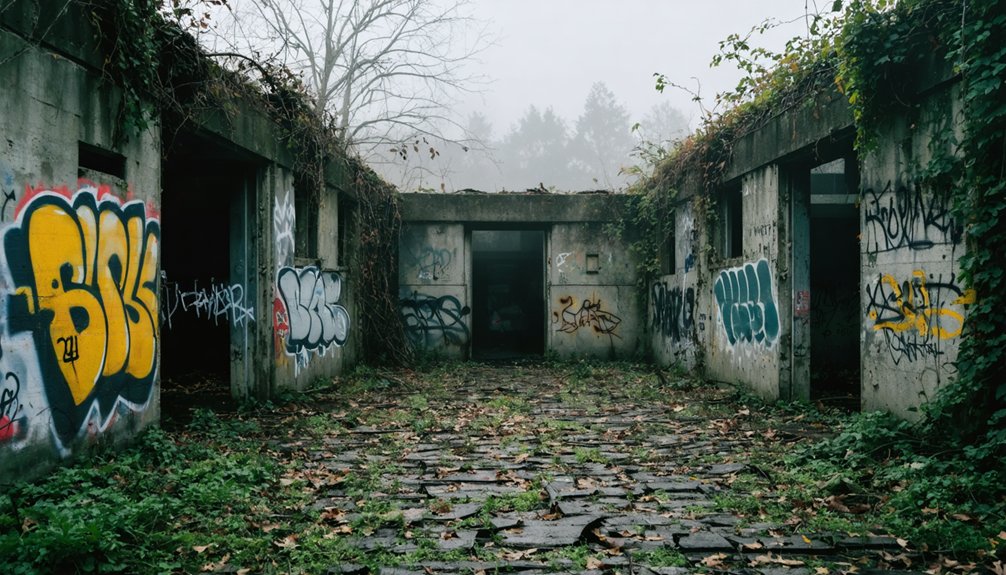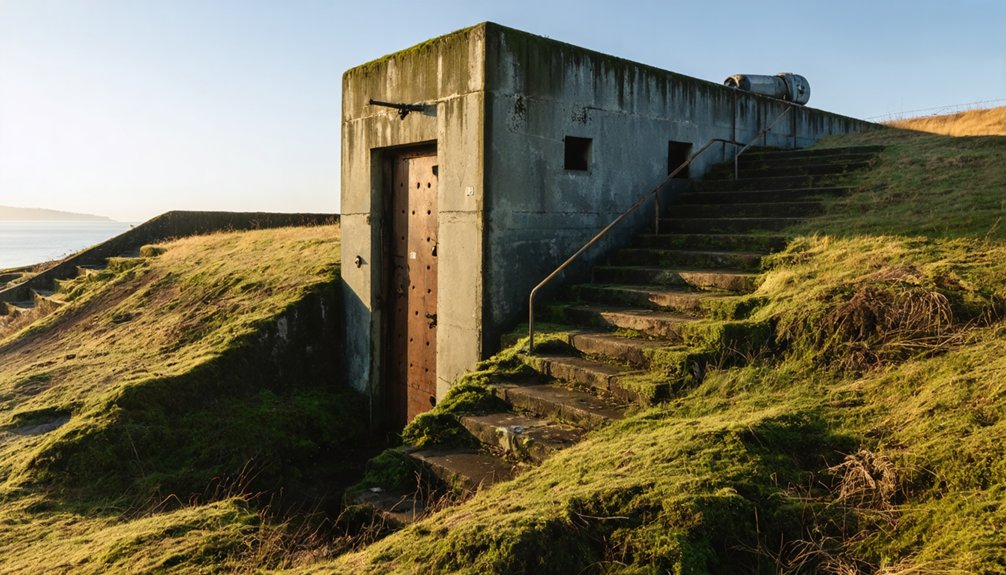America’s most intriguing abandoned military bases include Roosevelt Roads in Puerto Rico (8,650 acres of contaminated structures awaiting redevelopment), Camp Hero in New York (featuring sealed underground tunnels and conspiracy theories about secret experiments), and Fortuna Air Force Station in North Dakota (where a massive 70-ton radar dish once monitored Soviet threats). You’ll discover how these Cold War relics now serve as eerie time capsules of America’s defensive past while posing environmental and economic challenges to their surrounding communities.
Key Takeaways
- Roosevelt Roads in Puerto Rico spans 8,650 acres with abandoned structures and offers glimpses into America’s Caribbean military history.
- Camp Hero on Long Island features sealed underground tunnels, blast-proof structures, and persistent conspiracy theories about secret experiments.
- Fortuna Air Force Station in North Dakota preserves Cold War history with its massive radar installations and 118 abandoned buildings.
- These bases attract urban explorers and history enthusiasts despite environmental hazards and restricted access areas.
- Each abandoned military ghost town provides unique historical context, from WWII coastal defense to Cold War surveillance infrastructure.
Roosevelt Roads: Puerto Rico’s Toxic Military Ghost Town
Nestled on the eastern coast of Puerto Rico, Roosevelt Roads stands as a stark reminder of America’s military legacy in the Caribbean. This once-thriving naval base, commissioned in 1943 and operational until 2004, now exists as a contaminated ghost town haunting the municipality of Ceiba.
You’ll find an eerie landscape of abandoned structures spanning 8,650 acres—stripped buildings, medical facilities, and housing units silently deteriorating amid environmental hazards. Heavy metals and petroleum products plague the soil, complicating economic revitalization efforts that desperately aim to fill the $400 million annual void left by the base’s closure. The site was originally developed following Franklin D. Roosevelt’s suggestion in 1919 as a strategic military installation.
While environmental remediation continues under Navy oversight, the base’s 2025 military reactivation has sparked contentious debate among locals who simultaneously fear the toxicity yet recognize potential employment opportunities in a region still struggling from the original abandonment. Urban explorers often discover fresh footprints indicating that these abandoned spaces still see human activity despite the dangers.
Camp Hero: The Abandoned Base Behind Montauk’s Conspiracy Theories
Standing at the easternmost tip of Long Island, Camp Hero remains one of America’s most enigmatic abandoned military sites, where concrete bunkers and a massive radar tower rise from the Atlantic coastline like relics from a forgotten war.
Originally disguised as a New England fishing village with painted windows on bunkers, this WWII coastal artillery base later evolved into an Air Force radar station before closing in 1982.
You’ll find military secrets everywhere—sealed underground tunnels, blast-proof structures, and machine gun nests that once protected New York from German attacks.
Now a state park spanning 800 acres, Camp Hero’s Montauk mysteries endure through conspiracy theories about mind control and time travel experiments. These theories gained substantial public attention after Preston Nichols published The Montauk Project in 1992, claiming the site housed secretive government research. Documents revealed unusually large food orders worth $80,000 monthly continued after the base’s official decommissioning, fueling speculation about hidden operations.
While you explore the decaying military structures, remember that the federal government still owns what lies beneath your feet.
Fortuna Air Force Station: Cold War Relics Frozen in North Dakota’s Plains
High atop a windswept hill in North Dakota’s northwestern plains sits Fortuna Air Force Station, a forgotten Cold War sentinel that once formed a critical link in America’s radar defense network. Established in 1952 just 4.2 miles west of Fortuna, this 124-acre compound monitored northern skies for Soviet bomber threats with its massive 70-ton radar dish.
You’ll find the remnants of a once-thriving military community that abruptly disappeared after the station’s 1979 deactivation:
- The imposing five-story radar tower, now repurposed as a cell tower
- Concrete foundations where 118 buildings once housed the 780th Radar Squadron
- Historical signage along Highway 5 documenting this technological outpost’s significance
The advanced BUIC III system installed here in 1970 allowed Fortuna to control larger air defense sectors by accepting inputs from multiple radar sites across the region.
Like the nearby Mickelsen Safeguard Complex, Fortuna represents America’s defensive infrastructure against nuclear threats during the Cold War era.
The abandoned base stands as a stark monument to Cold War vigilance, now slowly reclaimed by nature.
Frequently Asked Questions
Is March Air Force Base Accessible to the General Public?
No, March Air Reserve Base isn’t abandoned and restricts public access. You’ll need government ID for entry, though you can experience its historical significance during annual air shows.
What Wildlife Now Inhabits These Abandoned Military Installations?
While you might expect barren landscapes, you’ll discover thriving ecosystems through urban exploration. Endangered species like California tiger salamanders, rare butterflies, and larger mammals have adapted, reclaiming these concrete jungles as their sanctuaries.
Can Visitors Legally Explore Babbitt’s Remaining Structures?
No, you can’t legally explore Babbitt’s remaining structures. Despite their historical significance, these structures sit on restricted military property where Babbitt exploration rules prohibit unauthorized access, with penalties for trespassing.
Are There Guided Tours Available at Any of These Locations?
Nearly 70% of abandoned military sites restrict access. You’ll find guided tours highlighting historical significance at Fort Monroe, Camp Hero, and occasionally Roosevelt Roads, though many locations remain off-limits for safety reasons.
What Items Were Left Behind When Fort Dearborn Was Abandoned?
You’ll find Fort Dearborn’s abandonment yielded typical military artifacts: furniture, metal tools, uniform fragments, and building materials. Archaeological discovery confirms these items’ historical significance through buttons, coins, and ceramic remnants.
References
- https://oldcc.gov/news/march-air-force-bases-downsizing-created-ghost-town-heres-whats-there-now
- https://www.operationmilitarykids.org/abandoned-military-bases/
- https://www.youtube.com/watch?v=9Xs418q7u9I
- https://www.youtube.com/watch?v=pcX5nv0XhCA
- https://www.youtube.com/watch?v=3d4bUMUUWxY
- https://abandonedwonders.com/tag/abandoned-military-base/
- https://www.youtube.com/playlist?list=PLenYgd5YLQJ744EWXrjBFt-EtBj8FFdPo
- https://www.youtube.com/watch?v=mFX-zQuWUo4
- https://www.youtube.com/watch?v=txuACj3SELs
- https://www.youtube.com/watch?v=_GXPCLi66xw



